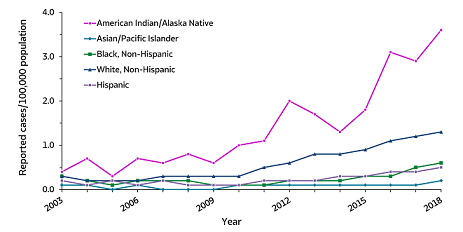Four Pillars of Elimination
Elimination is possible. Elimination depends on preventing new infections, improving health outcomes of people diagnosed with hepatitis, reducing stigma and barriers to culturally competent care, and generating hepatitis data that can inform policy decisions available to key partners and the general public.

1. Prevent New Infections
Preventing new infections relies on expanding harm reduction services and increasing vaccination against hepatitis A and B.
Information and Resources

2. Improve Health Outcomes
Increasing access to diagnosis and improving linkage to care will help cure hepatitis C and improve health outcomes for people living with hepatitis B.
Information and Resources

3. Eliminate Disparities and Inequities
Care that is culturally competent and addresses complex inequalities is vital for reaching populations disproportionately impacted by viral hepatitis.
Information and Resources

Rates of reported acute hepatitis C, by race and ethnicity — United States,
2003–2018, CDC
4. Improve Surveillance and Data Use
Gathering current data helps inform key policy decisions, detect and control outbreaks and inform the public about the impact of viral hepatitis.
Information and Resources